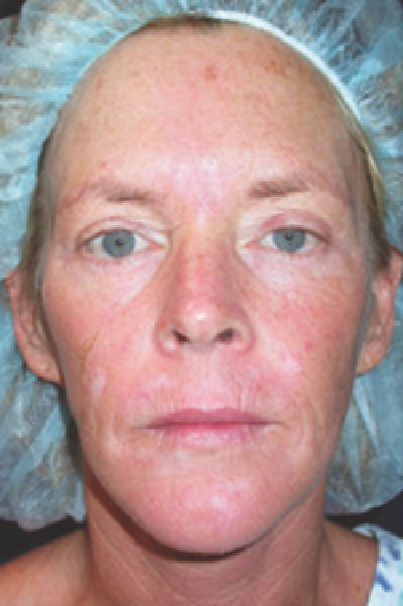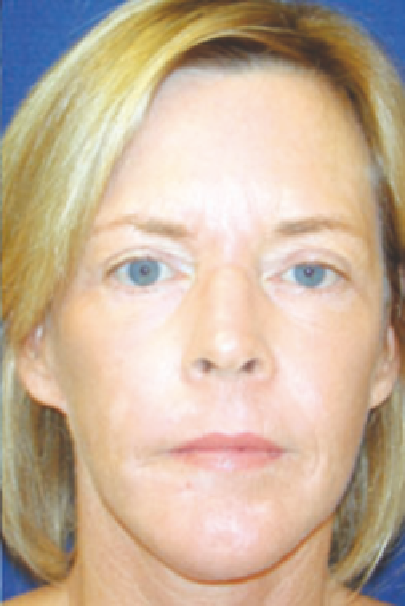Biomedical Engineering Reference
In-Depth Information
contraction and collagen fi bril diameter. Remarkably, the
degree of collagen contraction achieved in their study was con-
sistent with that achieved with a pulsed CO
2
laser in a previous
study using the same bovine tendon collagen model (294).
Fitzpatrick et al. compared the collagen tightening induced
by a pulsed CO
2
laser and the modulated Derma-K laser. One
eyelid, treated with three passes of a pulsed CO
2
(UltraPulse,
Coherent Medical Group, Santa Clara, CA now Lumenis), was
compared with the contralateral eyelid, treated with the
Derma-K laser (ESC, now Lumenis), to an endpoint of early
pinpoint bleeding. Intraoperative contraction of 43% after
CO
2
resurfacing versus 12% after Derma-K laser resurfacing
was measured. However, at 1 month and beyond, the degree of
CO
2
-induced skin tightening and that of modulated Er:YAG-
induced skin tightening was found to be identical (25).
scanner feasible. Alternatively, freehand ablation can be per-
formed effi ciently at a repetition rate of 5 Hz and with an over-
lap of 50% that produces the equivalent of two-pass ablation
in a single pass. Single passes are typically performed with a
20-30% overlap to prevent irregularities inherent to their
Gaussian beam. Up to 40
m of tissue per pass can be ablated
at a fl uence of 10 J/cm
2
with both, the Contour and CO
3
lasers
(272,284,289).
Long pulse durations with the currently available modu-
lated Er:YAG laser system, Contour TRL (Sciton Corp.), pro-
duce clinically evident, “CO
2
-like” intraoperative tissue
contraction during and after the second pass. As a general rule,
deeper rhytides and severe photodamage are optimally treated
with the longest pulse durations available, whereas superfi cial
rhytides and minimal photodamage are treated with short
pulse durations. Wiping between passes, although not neces-
sary, can afford a better view of rhytide effacement and depth
of vaporization (Fig. 6.42).
The short-pulsed mode of the modulated lasers can be used
for purely ablative functions such as fi ne tissue sculpting and
to remove the residual zone of thermal necrosis left behind by
the coagulative mode of these lasers. Removal of this zone of
residual thermal damage after CO
2
laser resurfacing has been
shown to improve postoperative healing.
The clinical endpoint during modulated Er:YAG laser skin
resurfacing is not obvious. The long pulses (coagulative) of
the modulated Er:YAG lasers produce excellent control of
intraoperative hemostasis. Thus, punctate bleeding, which
helps to signal the clinical endpoint during conventional
short-pulsed Er:YAG resurfacing, does not occur when resur-
facing with the modulated Er:YAG lasers. Furthermore, the
μ
Modulated Er:YAG Lasers: Clinical Considerations
Their capability to produce precise ablation at highly effi cient
rates, provide excellent hemostasis with their coagulative
pulses, and generate “CO
2
-like” thermally induced changes in
dermal collagen and their superior side effect profi le have
made these powerful modulated Er:YAG lasers a true alterna-
tive to the CO
2
laser.
In contrast to CO
2
laser resurfacing, treatment with the
modulated Er:YAG lasers can often be performed using local
anesthesia. Topical anesthesia, nerve blocks, and local infi ltra-
tion typically are supplemented with a benzodiazepine (i.e.,
midazolam or diazepam) and/or an analgesic such as fentanyl
or meperidine.
Currently available modulated Er:YAG lasers are powerful
systems with effi cient ablation rates that make the use of a
(
A
)
(
B
)
Figure 6.42
Treatment with the Cynosure CO
3
laser. (
A
) Before treatment; (
B
) 6 months after treatment with two passes at 10 J/cm
2
and 10 ms followed by
two passes with 10 J/cm
2
and 0.5 ms.




















